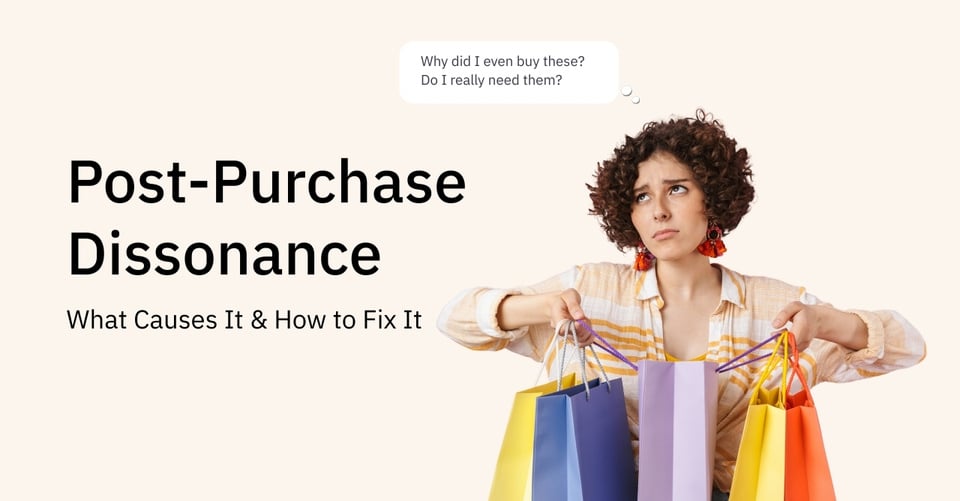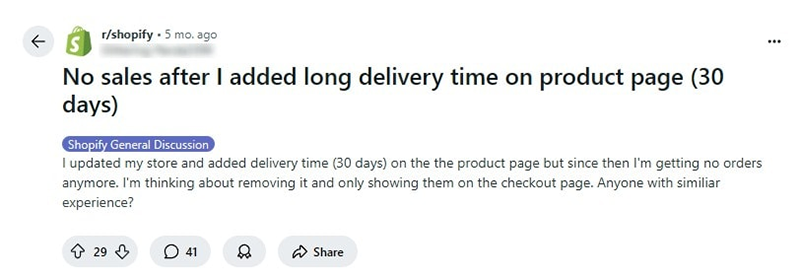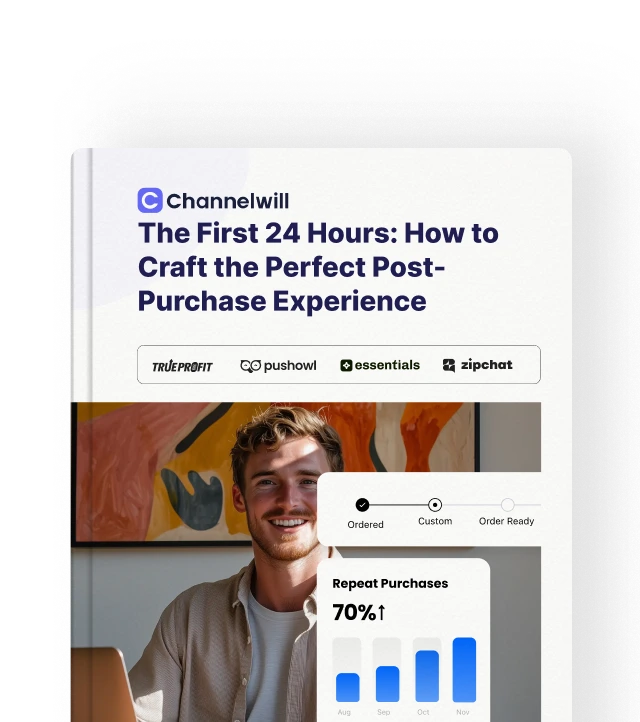Have you had customers who were excited to buy your product at first, but became anxious and started requesting a refund just a few days after? That might be because of post-purchase dissonance, and that’s the regretful feeling after buying something.
Here’s what’s surprising: four out of five Americans go through this at some point, even when they do their research before buying.
But where does this post-purchase dissonance come from? And how do we solve it?
In this guide, we’ll show you what triggers these post-purchase problems, share post-purchase dissonance examples, and give you some tips (and tools) to reduce the chances of it affecting your business.

What Is Post-Purchase Dissonance?
Post-purchase dissonance is when customers feel uneasy after making a purchase. It’s also called “buyer’s remorse.” And it’s commonly caused by doubt, delivery delays, unreached expectations, and lack of perceived value (more on this later).
Let’s say you own an electronics store. One new customer named Eric checked out a pair of $200 earbuds. While waiting for the item, he saw another pair of earbuds from your competitor. It was cheaper, but the features were the same. So, he started asking himself, “Did I make the wrong choice?”
When your item arrived, he was no longer excited. Eric felt disappointed and even considered returning the item.
That’s post-purchase dissonance right there. From this example, we can see that it’s not your fault, but that doesn’t mean it can’t hurt your business. You can lose a customer, get negative reviews (if they develop a bias), and even lose sales because of it.
So, whether it’s within your control or not, you have to do something about post-purchase dissonance. But we have to know what triggers these feelings in the first place.
What Triggers Post-Purchase Dissonance?
Poor or missing communication, vague delivery timelines, and unmet product expectations are the main triggers of post-purchase dissonance. Here’s why:
Poor or missing communication post-purchase
Poor or no communication after purchase is the fastest way to make your customers worry. And if they don’t hear from you (at all), they’ll start doubting their decision.
Missing or no communication is obvious. But what is considered poor communication? Good question!
Sending vague and generic updates is an example of poor communication. A dry “Your order [date of purchase] is on its way” will make your customer yawn and raise questions like “When exactly will I receive the order?”
Poor communication also means waiting a few days before sending shipping confirmations or providing tracking numbers that don’t work yet (those two big NOs).
Long or unclear delivery timelines
Another huge trigger of post-purchase dissonance is long or vague delivery timelines.
If you say something like, “Your order will be shipped in 5-7 business days,” your customers might misunderstand it. Does it mean that they will receive it within that timeframe, or just that it will leave your warehouse? Those unclear timelines can bring WISMO tickets to your team.
Long delivery timelines can also create anxiety for your customers, even if you mentioned it upfront. Take this Shopify store owner as an example. Their sales went down to zero after they added a “30-day delivery timeline” to their product page.

It’s more about pre-purchase. But we can see how it affected the customers’ psychology. You’re giving them 30 whole days to wonder if they made the right choice or check out your competitors. That’s a lot of time for buyer’s remorse to build up.
Product not matching expectations
Exaggerated claims, wrong supplier choices, misleading product photos, and poor item descriptions are some common causes of a product not matching expectations.
This post-purchase dissonance trigger is more common with dropshipping stores. We know a lot of responsible dropshippers who bought samples and fully tested their items before selling them.
But some suppliers change materials or manufacturing processes without notice. And that can affect the quality of the next batches… that even careful testing can’t prevent.
Imagine you sold a “premium leather wallet” in your store. On your product page, you said that the materials were genuine Italian leather with hand-stitched details. But when your customers received the item, they noticed the wallet felt cheap and lacked subtle craftsmanship.
That disconnect between promise and reality triggers instant buyer’s remorse.
How Post-Purchase Dissonance Affects Your Business
Post-purchase dissonance can cost you money through refunds, hurt your reputation with negative reviews, reduce your repeat customers, and overwhelm your support team with WISMO questions.
Let me explain each effect in detail:
Leads to order cancellations or refund requests
Around 76% of customers say a bad customer experience is worse than actual product delays. That means staying silent about shipping updates creates more problems than telling customers their order will be late.
Let’s say you had a flash sale and offered a 30-50% discount on all your bags and luggage. Orders poured in during the 48-hour sale period, but because of the unexpected volume, your team became so busy that they forgot a non-negotiable step: sending order confirmation emails.
Even after reaching out to you, your team took so much time to answer, and some messages were even ignored (oops). This poor consumer’s experience becomes a huge reason customers cancel their orders and ask for refunds.
Increases support workload (WISMO tickets, live chat demand)
Your customer support team is the one to suffer the most when there’s a problem with the order. WISMO questions will be coming non-stop during their shift. And they won’t be able to do more productive stuff.
Do you remember the flash sale example above? You could see how many contact points there were: when they didn’t receive the confirmation email, when they reached out asking about their order status, and when they finally asked for refunds.
If there are 60 people who constantly contact support within that week after the purchase, we’re talking about 600 minutes (10 hours) of your team’s time. Wow. That’s more than one working day.
Triggers negative reviews or customer complaints
Post-purchase dissonance can also push your customers to say something bad about your product (or brand). Especially when they feel like it’s your fault that they aren’t happy with their purchase.
Here’s the issue: while some dissatisfied customers go directly to your team to complain, others tell the world. They post it on Reddit, social media, Google reviews, and on your product page. These reviews stay online for years. And it can scare a lot of potential buyers who see them.
Take what happened to the luxury sneaker store (DS Sneakers). Their customers started posting negative reviews like “Please do not purchase from here, they are a scam” and “Never received my $4,000 order” on social media platforms. And the reason? Because of poor communication and delayed orders.
The business has taken a hit, and as of now, they have already closed two of their physical stores.
Damages customer lifetime value (CLTV) and repeat purchase potential
CLTV and repeat purchase are the best sources of revenue for your business. And around 72% of customers are willing to spend more if you provide a great customer experience.
If you’re not giving that to your customers (because of delivery delays and poor communication), you’re saying goodbye to all that potential revenue.
A few years ago, one of our clients couldn’t increase their CLTV. They did get consistent new orders, yet their repeat purchases were close to zero. The issue was the lack of shipping updates on their part. After they found the culprit and fixed it, their repeat purchase jumped to 35% in a short period.
These issues may be serious (and scary). But don’t worry! There’s a way to lessen post-purchase dissonance, and we’ll talk about that next.
How to Minimize Post-Purchase Dissonance with Better Tracking
The best way to prevent post-purchase dissonance is through real-time tracking, branded pages, proactive notifications, and accurate delivery estimates. Here’s how each approach helps:
- Give real-time tracking updates: 80% of consumers want delivery status updates. That means letting your customers check their package location anytime stops the spiral of doubt that leads to cancellations and returns. With this feature, you can increase transparency and enhance customer satisfaction.
- Use branded tracking pages: Bring your customers back to your website instead of sending them to generic carrier sites. Having your own tracking page keeps your brand visible and reduces WISMO tickets because they can find answers themselves.
- Send proactive shipping notifications: When customers receive updates about their order being processed, shipped, and out for delivery, they feel connected to the purchase journey. And satisfied customers appreciate being kept in the loop without having to ask.
- Provide accurate delivery estimates: Clear estimated delivery times help customers plan and reduce uncertainty. When you can tell customers “your order will arrive Tuesday between 2-6 PM” instead of “ships in 3-5 business days,” you set proper expectations.
- Add tracking links to confirmation emails: You can also include tracking information directly in your order confirmation and shipping emails. So, your customers won’t need to waste time looking for it like Easter eggs.
Channelwill’s ParcelPanel Order Tracking can help with this. We offer branded, multilingual tracking pages with automated delivery updates that work across 1,400+ carriers.
Our real-time sync reduces WISMO tickets by up to 75% while turning post-purchase anxiety into revenue opportunities and positive customer experience.
#1 Shopify Tracking Solution for eCommerce
Turn Returns Into Positive Experiences
When you handle returns well, you turn a negative experience into proof that your brand cares about customers (and they’ll remember you for it).
Returns happen at the peak dissonance moment when your customers are questioning their purchase decision. But a smooth return process can bring customer confidence back in your brand… and encourage repeat business.
For example, self-service return portals give them control to check updates whenever they want. And they can escape the email ping-pong with your support team.
Return management platforms like ParcelPanel can give your customers a memorable return experience. It provides features that reduce customer inquiries and improve customer retention. Like… a branded (well-optimized) return page and automated notifications for proactive communication. They won’t have to reach out to your team to get updates.
Here’s why using our app is way better than the usual email process:
| Generic Email Process | Channelwill’s ParcelPanel Returns & Exchanges |
| Customer emails your support team | Self-service return portal |
| Manual back-and-forth emails | Automated return notifications |
| Refund only | Multiple options: refund, store credit, exchanges |
| Time-consuming for your staff | Automated workflows and approvals |
Besides self-service return, clear return policies prevent anxiety, too. When customers know they can easily return something, they’re more likely to buy in the first place. And that can reduce post-purchase dissonance caused by doubt.

Make returns and exchanges hassle-free to reduce costs
Proactive Tips to Prevent Dissonance Before It Starts
The best way to prevent post-purchase dissonance is to manage customer expectations and reassure them right after the purchase. Here are some tips for you:
- Set realistic expectations during checkout: You have to be honest about delivery times during checkout. Don’t promise 3-5 days if it usually takes a week. Keeping your timelines realistic helps meet expectations and prevent disappointment later.
- Highlight product benefits in confirmation emails: Remind your customers that they made a great choice by showing product benefits they’ll enjoy. With them, you can fight the doubts that start forming in their mind post-purchase (which happens more than you think).
- Provide instant access to policies: It’s important to make shipping and return policy information easy to find after purchase. You can add FAQs like “When will my order ship?” and “Can I return it?” directly on your thank-you page… so your customers won’t have to hunt for answers.
Final Thoughts
So, that’s everything you need to know about post-purchase dissonance and how it’s affecting your business.
Remember that when your customers experience post-purchase dissonance, it hurts your future sales and affects the customer journey. But you can do something about it… and you can start with better order tracking and proactive communication.
Ready to reduce post-purchase dissonance in your store? Try Channelwill’s Order Tracking and Returns & Exchanges for free. With it, you can give your customers the transparency and control they need after making a purchase.
FAQ About Post-Purchase Dissonance
Post-purchase syndrome is when your customers feel uneasy or regretful after buying something. It’s also called post-purchase (cognitive) dissonance or buyer’s remorse.
One example of dissonance buying behavior is when a customer buys a $300 smartphone and immediately starts researching cheaper alternatives. They question their decision, worry they overpaid, and feel anxious until the phone arrives.
Note: This blog was originally written in English and translated using an automated tool to make the content accessible to a global audience. We believe in sharing valuable insights with everyone and apologize for any inaccuracies. If you spot any errors, please feel free to contact us for corrections. Your feedback helps us improve and ensures the content’s value is fully realized.

Content Director | 9+ years decoding B2C & B2B eCommerce, obsessed with SaaS and retail storytelling
Words are my weapon—crafting killer copy, decoding trends, and turning data into gold. When not strategizing: Coffee addict, pun enthusiast, and book lover. Ready to level up your eCommerce game? Let’s chat. ☕️




